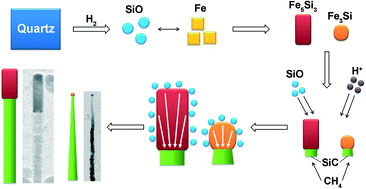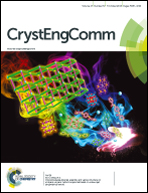Role of catalyst in controlling the growth and morphology of one-dimensional SiC nanostructures†
Abstract
To control the morphologies of one-dimensional (1D) nanostructures, especially during the catalyst-assisted growth of semiconductor nanostructures, is the key to unlock their potential applications. In this work, we demonstrate that, the morphology of the 1D silicon carbide (SiC) nanostructures can be controlled by manipulating the composition of the catalyst in the microwave plasma chemical vapor deposition process. It is revealed that iron silicide presents as the main catalyst to initiate the growth of 1D SiC nanostructure. High-resolution transmission electron microscopic analysis shows that, the stoichiometry of the iron silicide governs the final morphology of 1D SiC nanowire. For the growth of SiC nanowires, the catalyst is Fe5Si3, while it is Fe3Si for SiC nanoneedles. A special orientation match between the iron silicide catalyst and the SiC nanowire is observed for the first time during the growth of SiC nanostructures. The mechanism for the different morphology of the SiC nanostructures is believed to be the different etching resistivity of the catalyst particles under H2 plasma etching. Based on the above mechanism, a continuous change in the morphology of the SiC nanostructures has been achieved by controlling the supply of Si during growth.


 Please wait while we load your content...
Please wait while we load your content...